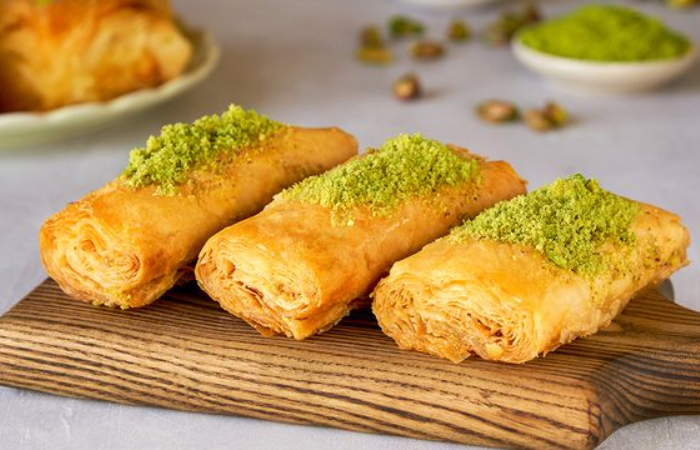Middle Eastern Desserts: A Halal Culinary Journey
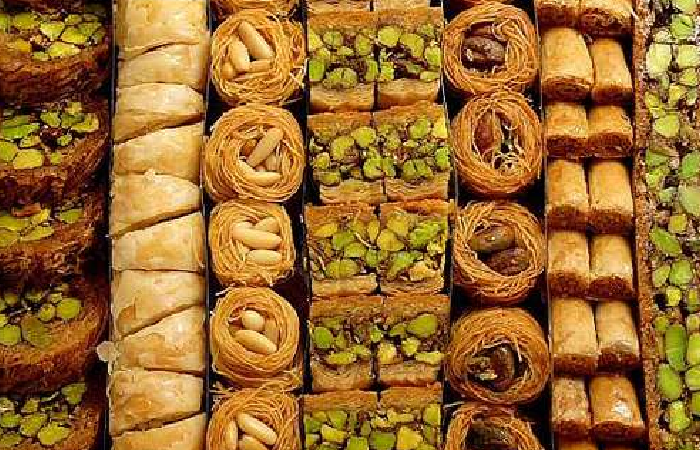
The Middle East has a rich and varied array of sweet delights. Each reflects the distinct influence and tradition of its own country or region. There's a dessert for everyone, from phyllo-wrapped delights in Turkey and Greece to milk-based puddings in Egypt and date-infused sweets of the Arabian Peninsula.
More than simply a delightful way to cap a meal, these desserts are also an important aspect of cultural events and social gatherings. From sharing platters of baklava with friends and family to indulging in a bowl of umm Ali on a cold winter night, these sweets bring people together and foster lasting memories. So, let's start our halal culinary journey through the world of Middle Eastern desserts. And also learn some quick takes on Easy Middle Eastern Recipes.
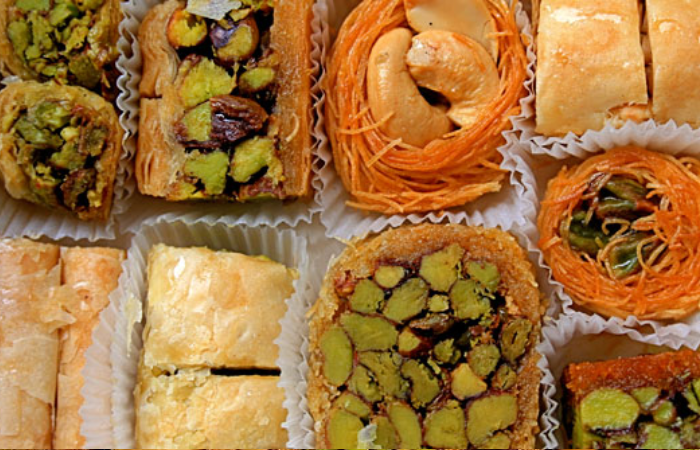
Introduction
Desserts are a crucial part of the Middle Eastern cuisine. They are typically available throughout the day, either for serving at tea or after dinner.
Desserts are usually served with frothed Turkish coffee or mint tea. They represent of friendship, happiness, joy, and generosity. Desserts are a vital part of any special occasion, including weddings, holidays, festivals, and daily meals.
Importance of Halal Certification in Middle Eastern Cuisine
- Consuming only halal food is a religious responsibility for Muslims, as defined by Islamic dietary guidelines in the Quran and Hadith
- Traditional middle eastern cuisine enjoys the benefit of halal certification which ensures its end users to enjoy the delights with ease and freedom, without worrying about the ingredients and halal status.
- Halal food transcends religious beliefs and serves as a common cultural identity and social glue in many Middle Eastern countries.
- Muslim consumers represent a big and expanding worldwide market. Halal certification allows firms to enter into this lucrative industry and broaden their reach.
- Tourists choose halal-friendly sites and certification encourages Muslim visitors, which boosts tourism economies.
- Halal certification entails stringent inspections and requirements, which promotes improved quality and hygiene in food production.
To sum it up Halal Certification serves as a mark of trusted label for muslims and non muslims alike to enjoy their sweets with ease.
Traditional Middle Eastern Desserts
Due to their unique tastes and textures, traditional Middle Eastern desserts are well-liked worldwide and will captivate you with their sweetness. The top six Middle Eastern desserts are included here, though there are many more that might win your heart.
Baklava: Layers of Sweetness and Flakiness
One of the most well-known Middle Eastern desserts is baklava. It is made by placing thin phyllo dough between layers of nuts, such as hazelnuts, pistachios, and walnuts, according to where it is made. It is made sweeter with a simple syrup (honey or sugar).
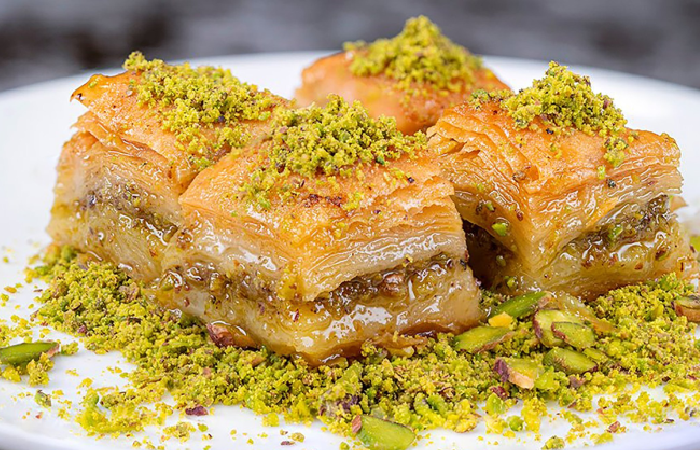
Baklava is a highly skilled dish to produce and is served with great care to esteemed visitors as a token of their worth. However, it is a staple of special events, particularly religious festivals, when every home prepares at least one tray of baklava.
Baklava is the undisputed king of Middle Eastern desserts. It is found anywhere in the world. But if you want to try the best of the best, then you must visit Gaziantep. It's a haven for baklava lovers and the best location to eat in all of Turkey.
Kunafa: A Delightful Combination of Cheese and Semolina
Kunafah is a classic Middle Eastern delicacy made with spun pastry called kataifi. It is soaked in a sweet syrup made of sugar called attar, and usually stacked with cheese or, depending on the region, other ingredients like pistachios, almonds, or clotted cream.
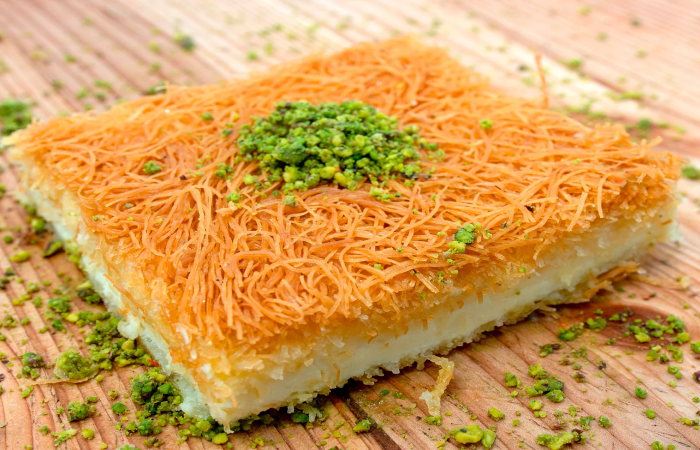
Made of crunchy kataifi dough, akawie cheese, and oozy ricotta, kunafah is a cheese-based pastry that is sweetened with rosewater syrup.
A layer of cheese is placed between the kadaifs, which have been pressed onto a copper tray along with some melted butter. When kunafa, or künefe, is filled with sherbet, it is baked or cooked until it turns brown on both sides.
Basbousa: Sweet Semolina Cake Soaked in Syrup
Basbousa, is also known as harissa or namoura. The Levant region of the Middle East is home to this highly popular dessert. It is a flavorful syrup encasing a delectable semolina cake.
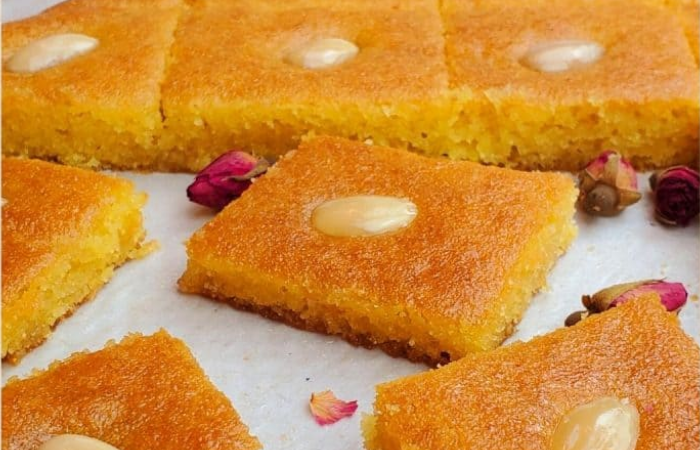
The grainy semolina in the cake gives this popular Middle Eastern treat a distinctive texture. It's highly recommended to try this simple treat!
Halawet El Jibn: Creamy Cheese Rolls Drizzled with Syrup
Halawet El Jibn (حلاوة الجبن) literally translates to "sweetness of cheese." This classic Middle Eastern dish is made of soft, sweet cheese pastry and filled with cream. Rose petal jam and pistachios are used as garnish. A drizzle of syrup completes this delicious delicacy. The scent of orange blossoms and rose water are combined to create this syrup.
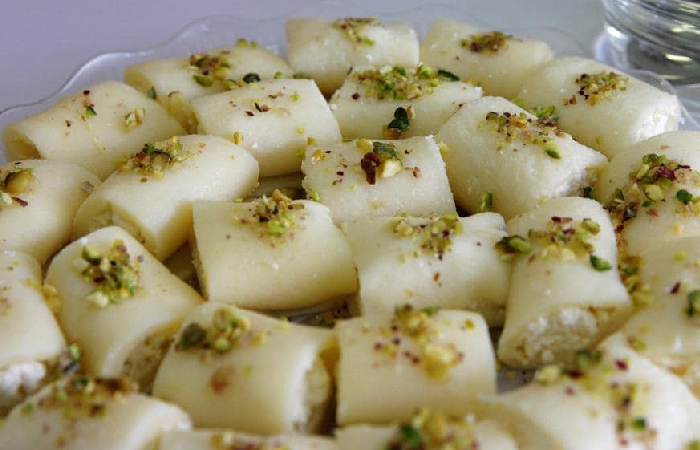
It is thought that the Palestinian city of Nablus is where this cuisine originated. It is now well-known throughout the Middle East, Although it's usually served during Ramadan, you're free to have it on any other day.
Mahalabia: Silky Milk Pudding Perfumed with Rose Water
Mahalabia is a delicious milk pudding. It has a subtle scent of rosewater and smooth, velvety texture. This dessert can be served on any occasion as it's easy to make and incredibly fulfilling.
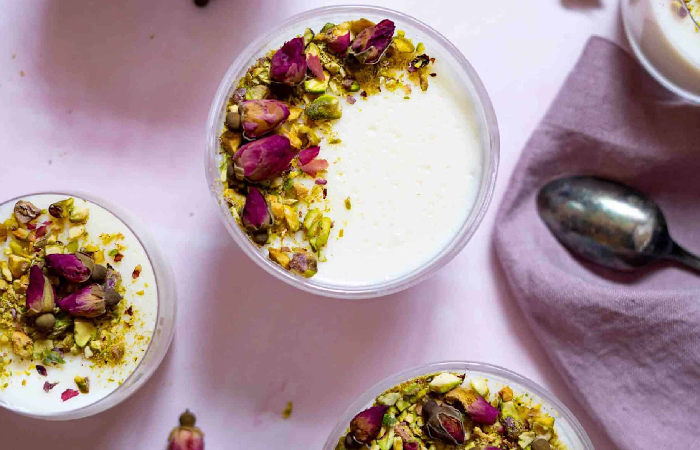
Usually, a mixture of milk, sugar, flour, and sugar are used to make it. One of three thickening agents is used to make it either rice flour, cornstarch, or wheat starch (but not all three!).
Serving it in tiny, individual dessert cups on a pretty plate with some tea or coffee is the most elegant presentation option. It will make your supper more elegant!
Znoud El Sit: Fried Pastry Filled with Cream and Drenched in Syrup
Znoud El Sit, which translates as "the arms of the lady" in Arabic, is a classic Middle Eastern delicacy made of crispy phyllo dough rolls filled with Ashta, a sweet cream. Znoud El Sit's sweet cream filling is created with whole milk, cream, or a mix of the two.
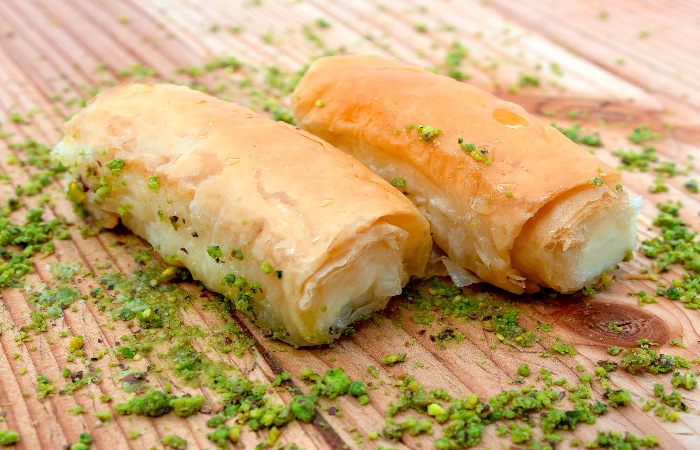
After deep-frying the rolls until they turn golden brown, they are soaked in a simple syrup. Znoud El Sit can be consumed on any other occasion, although it is typically served during Ramadan.
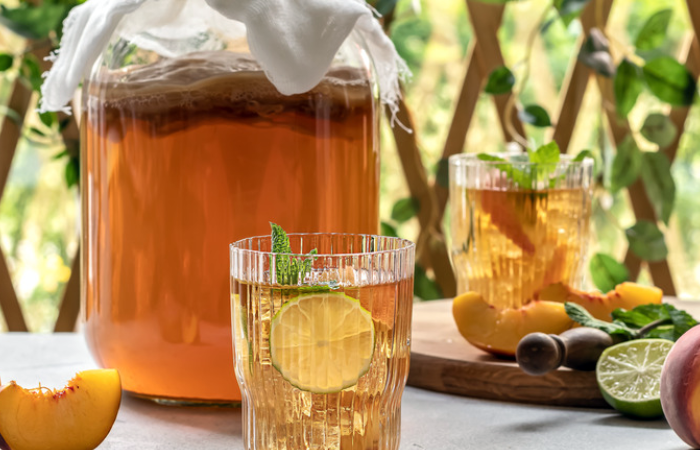
Easy Middle Eastern Dessert Recipes
The desserts discussed above are amazing middle eastern desserts. Here we are sharing some quick recipies of the dishes which otherwise require elaborate preparation.
- Quick Baklava Cups: Bite-Sized Treats with All the Flavor
- 10-Minute Kunafa Parfaits: Layers of Crunch and Creaminess
- Basbousa in a Mug: Microwave-Friendly Single Servings
- No-Bake Halawet El Jibn Bites: Simple and Scrumptious
- Rose Milk Pudding Smoothie: A Refreshing Twist on Mahalabia
- Cheat's Znoud El Sit: Simplified Version of the Classic Pastry
In times of these fast food race , you can try these easy middle eastern recipes which are quick to make without compromising on the quality. They retain almost exactly the parent recipies taste and sweetness. so let's begin with out most favoutite baklava!!!
Quick Baklava Cups: Bite-Sized Treats with All the Flavor
Baklava is a classic dessert in Greek, Turkish, and Arabic cuisines. It is a type of delicious pastry filled with chopped nuts and covered in honey syrup, formed from delicate layers of phyllo dough. It comes in a variety of forms with interesting flavors and fillings.
Baklava cups are little bite-sized cups which are an ideal dessert for a celebration. They have all the classic baklava's crispy, flaky, syrupy-sweet flavor. However, they are much easier to prepare.
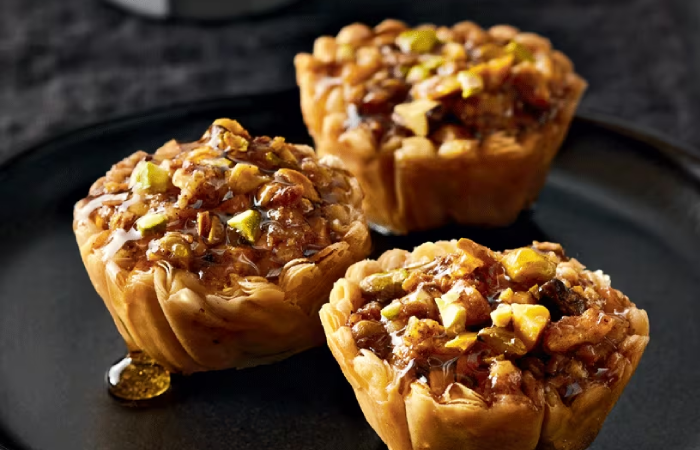
Learn how to make small baklava in phyllo cups, which are easily available from the freezer section of any grocery store. You also learn to make an easy homemade honey syrup. Rather than laying sheet after sheet of phyllo dough by hand, these little baklava bites are made with traditional nut filling, and syrup. They are more akin to tiny baklava tarts.
Ingredients:
- Baked Nuts: Traditional baklava recipes call for walnuts and pistachios, but you may also use almonds, cashews, pecans, or hazelnuts.
- Dates: Dates add a naturally sweet and almost caramelized flavor to this dish after baking. Hence less sugar is needed in this recipe.
- Sugar: You only need one tablespoon of sugar to make these mini Baklava! You can use brown or coconut sugar instead of the granulated white sugar that I recommend.
- Spices: Add more warm, aromatic spices like as cardamom, ginger, or allspice. Here, cinnamon, cloves, and salt are the main spices used.
- Butter: All it takes to provide a rich, soothing flavor and scrumptiously crisp texture to your nut filling is a small amount of melted butter. Use coconut oil as a replacement if necessary.
- Phyllo Shells: Look for prepared small phyllo pastry shells in the freezer department of your local grocery store! To prepare this simple recipe for baklava cups, you will need at least 3 packages, as they usually come in packs of 15 shells each.
- Honey Syrup: You can make a simple honey syrup at home using just water, sugar, honey, and lemon juice to glaze your little baklava tarts! This is a famous ingredient that takes only 15 minutes to prepare in traditional baklava recipes.
How to Make Honey Syrup?
Ingredients:
- ½ cup of cold water
- ¼ cup sugar
- ¼ cup honey
- 1 Tbsp lemon juice
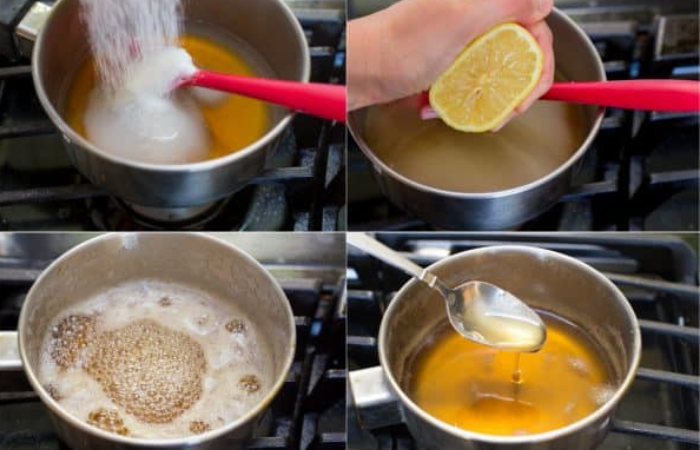
- Start by filling a saucepan with half a cup of cold water. Stir in the granulated sugar.
- After the sugar has dissolved, whisk in one tablespoon of lemon juice and honey. Make sure everything is properly combined.
- After bringing the mixture to a boil over high heat, reduce the heat and allow the honey syrup to steep for 10 to 20 minutes.
- Or until it begins to thicken. It should have a syrupy consistency and be liquid enough to pour over the baklava cups.
- After taking the pot off of the burner, leave the honey syrup aside.
Mini Baklava Cups
Stuffing Ingredients
- ⅓ cup walnuts
- ⅓ cup pistachios, shelled
- ⅓ cup hazelnuts, or almonds
- ⅓ cup pitted dates, rough chopped
- 1 Tbsp sugar
- ½ tsp cinnamon
- pinch of ground cloves
- ¼ tsp salt
- 1 Tbsp butter, melted
- 3 packs mini phyllo pastry shells, (45 shells total, 15 per pack)
Preparation:
- Toast the nuts:
Spread out your preferred nuts evenly on a baking sheet and toast them at 350°F until fragrant and brown. This should take ten to fifteen minutes. Let them cool before making the nut mixture.
- For the filling mixture:
Pulse your melted butter, sugar, spices, toasted almonds, and dates in a food processor. keep pulsing until the mixture is well-combined and finely chopped.
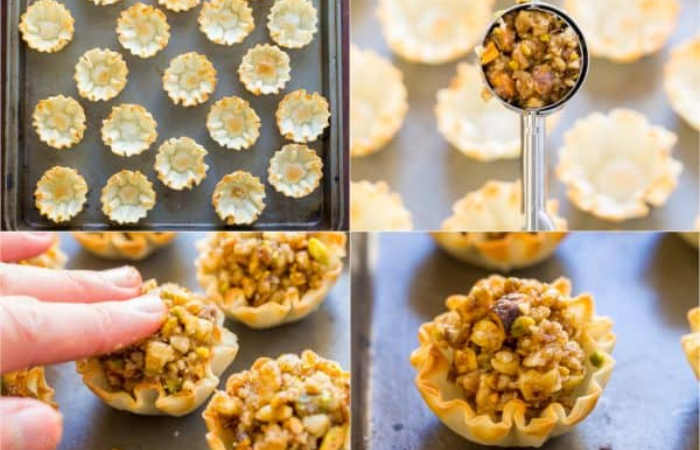
- Fill your tiny phyllo shells:
Take out your frozen phyllo cups and place them on a baking sheet that has been lined; there's no need to thaw them. Spoon about 1 tsp or more of your nut filling into each phyllo cup. (I prefer to stuff them so they're lovely and full!)
- Bake the baklava cups at 350°F for 10 minutes:
There's no need to cook phyllo pastry cups because they are cooked through before they are frozen. Simply bake until the phyllo cups are crisp and browned and the nut filling is heated through.
- Finally, drizzle the honey syrup:
Once the little baklava bites are cooked completely, take them out of the oven.
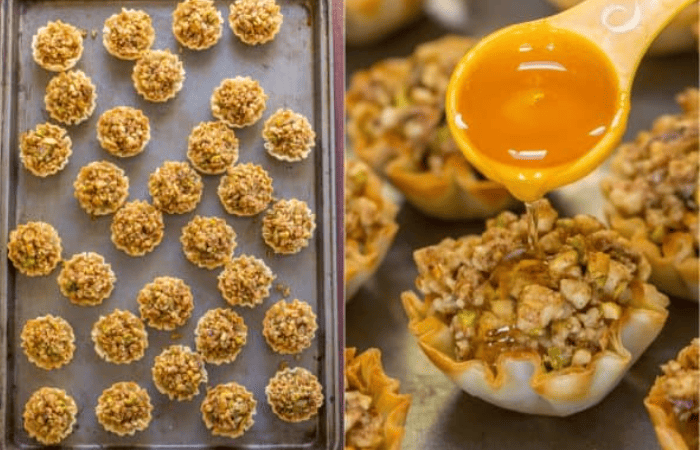
Drizzle them with the honey syrup while still warm. Top each baklava cup with about ½ tsp of syrup.
- Before eating, chill or give it a rest:
Before serving, place your tiny baklava in the refrigerator (or let it sit at room temperature) for at least five hours to let the syrup to seep into the filling and phyllo cups.
FAQ's About Baklava
What are the different variations in Baklava?
- Varieties of baklava is made only by variation in filling and the drizzles.The center of the syrup-drenched baklava is filled with chopped walnuts or pistachios rather than a mixture of nuts as an alternate.
- The syrup may be flavored with aromatics like cardamom, rose water, or orange blossom water, depending on the region in which it is made.
Which Baklava is the best?
The most well-known Baklava is Kuru Baklava.
Which country has the best Baklava?
- Bakhlava fom Turkey is cherished the most. You can find any kind of nut in baklava, although pistachios are the most popular and desired variety.
- The airy, flaky texture and sweetness of Syrian baklava is also well-known.
What is the difference between Greek and Turkish Baklava
Turkish baklava is typically made using a light neutral oil, whilst Greek baklava is typically made with melted butter. Tthe Greek version of baklava uses walnuts, with a little almond, the Turkish version mainly uses pistachios.
Why is baklava expensive?
Baklava is made using premium quality ingredients like butter, sugar, phyllo dough, and nuts (typically walnuts or pistachios). These ingredients are expensive, especially if you're using high-quality nuts.
How long can we store Baklava?
Baklava keeps well for at least two weeks in storage. It ought to be kept refrigerated or at room temperature in an airtight container. Retaining the crispness requires room temperature storage. Keep your baklava in the fridge if you prefer it chewy and somewhat firmer.
Can Baklava be froze?
Baklava can be wrapped and frozen for up to four months after it has baked and cooled fully.
10-Minute Kunafa Parfaits: Layers of Crunch and Creaminess
The best Middle Eastern dessert is kunafa. An exquisite, crisp, and buttery shredded fillo (phyllo) layered with smooth cream, topped with nuts and a flavorful simple syrup drizzled to perfection.
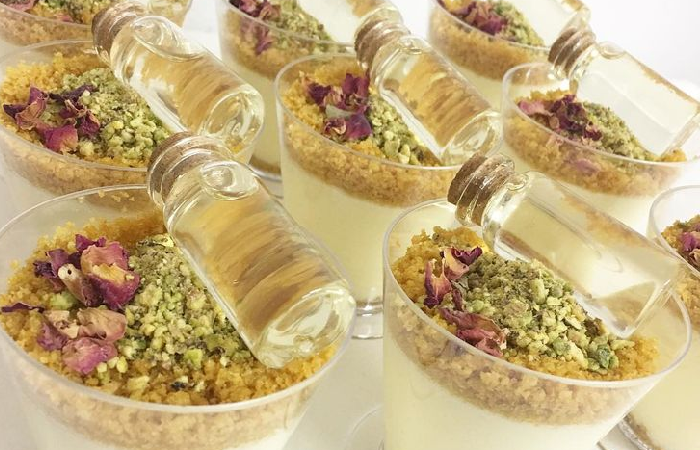
Ingredients For Lemon Syrup:
- 1 ½ cups (345 g) of granulated sugar
- 1 cup (240 mL) of water
- Juice from half of a lemon
- 1⁄2 teaspoon (2.5 mL) of rose water
Preparation
- To start with, combine 1 ½ cups (345 g) granulated sugar, half a lemon's juice, and 1 cup (240 mL) water.
- Mix it and heat on medium-high while stirring the mixture often.
- This will prevent the sugar from burning.
- Take the pan off of the burner when it's ready.
- The liquid will appear transparent.
- Add rosewater to reduce the tanginess of the lemon syrup
Ingredients For Parfraits:
- 1 lb (454 g) of kataifi dough—shredded phyllo dough
- 1 cup (225 g) of melted butter
- 1 lb (453 g) of cream, ricotta cheese, or mozzarella cheese
- 2 cups (240 g) of chopped walnuts or pistachios (optional)
- 2 tablespoons orange blossom water
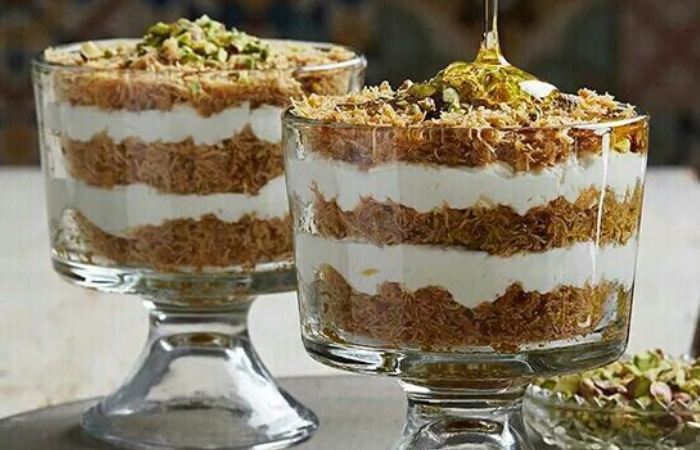
Preparaing The Kunafa Parfrait:
- Preheat oven to 375°F (190°C). Line a baking tray with parchment paper. This is done to reduce preparation time.
- Use your fingers to shred the clumped strands of the dough. After you thaw it nicely, add the melted butter.
- You may readily find kataifi dough in Greek or Middle Eastern supermarkets. It's also available at any local supermarket in the international food area.
- Mix the strands to make sure they are uniformly coated in melted butter.
- Bake it in the over until golden brown
- In a bowl, mix together the ricotta, mozzarella, powdered sugar, and orange blossom water. Mix until creamy and smooth.
- Divided the phyllo pastry into two bowls or glasses.
- After putting a layer of phyllo dough, top it with half of the cheese mixture and half of the chopped pistachios.
- Continue by covering the phyllo, cheese, and pistachios with another layer.
- Pour some lemon or rosewater syrup on top (optional).
- Serve immediately to savor the flavorful and textural fusion!
Basbousa in a Mug: Microwave-Friendly Single Servings
Want to enjoy the rich, sugary flavors of basbousa but don't want to prepare a big quantity or preheat the oven? With the help of this cup recipe, you can have a warm, delectable individual serving in a matter of minutes utilizing your microwave.
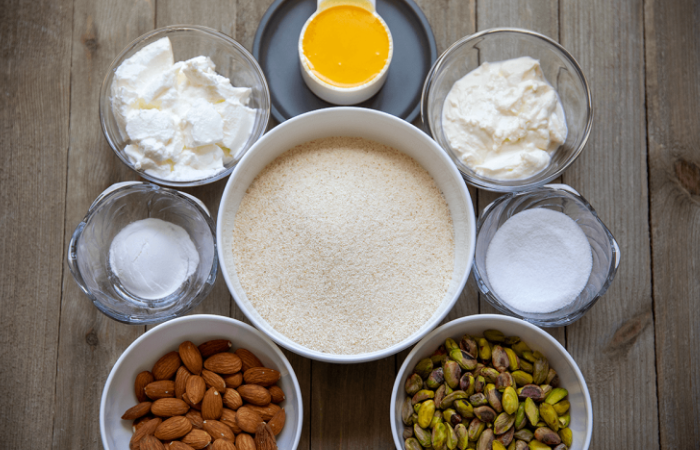
For the syrup:
2 tablespoons sugar
2 tablespoons water
1 tablespoon rosewater (optional)
Preparation Of Syrup:
- Prepare the syrup in a small saucepan.
- Stir together the sugar and water.
- Boil until the sugar dissolves.
- Lower the heat and cook for another 2–3 minutes.
- Add the rosewater, add stir.
- Your syrup is ready
Ingredients:
- 1/4 cup semolina flour
- 2 tablespoons sugar
- 1 tablespoon plain yogurt
- 1 tablespoon milk
- 1 tablespoon vegetable oil
- 1/4 teaspoon baking powder
- Pinch of salt
- 1 tablespoon chopped nuts (optional)
Preparing Basbousa In A Mug:
- Stir together the semolina flour, sugar, baking powder, and salt in a cup.
- Make sure the cup you are using is microwave safe.
- Mix the yogurt, milk, and oil in a blender until a smooth.
- Stir in the chopped nuts.
- Add this mixture to the cup.
- Use microwave on a high power, and cook for 1–2 minutes.
- Check the cake with a toothpick.
- If it comes out clean your cake is done.
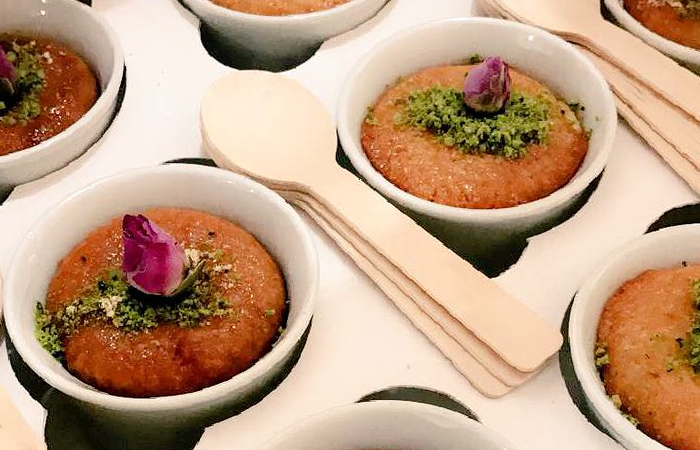
Once the baking is done, allow the Basbousa to cool inside the mug.
Pour the warm syrup over the cake, give it a few minutes to absorb.
Garnish it with nuts if desired.
Enjoy your warm, delectable Basbousa from a mug!
Tips:
- Use a large mug that can carry at least 12 ounces of liquid to avoid overflow.
- Use your imagination while choosing toppings!
- You can garnish with a sprinkling of cinnamon, a dollop of whipped cream, or even a drizzle of honey.
- To create more servings, double or triple this recipe.
No-Bake Halawet El Jibn Bites: Simple and Scrumptious
Want to enjoy the delectable flavors of Halawet El Jibn, the traditional Middle Eastern sweet cheese rolls. Here is a convenient and hassle-free recipe of these bite-sized, no-bake sweet treats! With little effort and no baking involved, this recipe is perfect for satisfying any sweet craving at any time.
Ingredients:
- 1 cup shredded mozzarella cheese
- 1/2 cup semolina flour
- 1/4 cup sugar
- 1/4 cup unsalted butter, softened
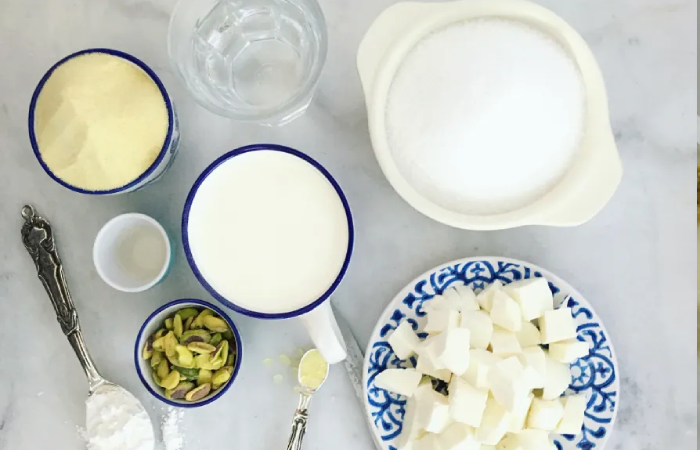
- 1 tablespoon rosewater (optional)
- 1/4 teaspoon ground cardamom
- Pinch of salt
- 1/2 cup chopped pistachios (or other nuts of your choice)
- Powdered sugar, for dusting
Preparing Halawet El Jibn:
You can start preparing these yummy bites by adding in a medium sized bowl:
- Shredded mozzarella cheese
- Semolina flour
- Sugar
- Softened butter
- Cardamom
- Rosewater
- Salt
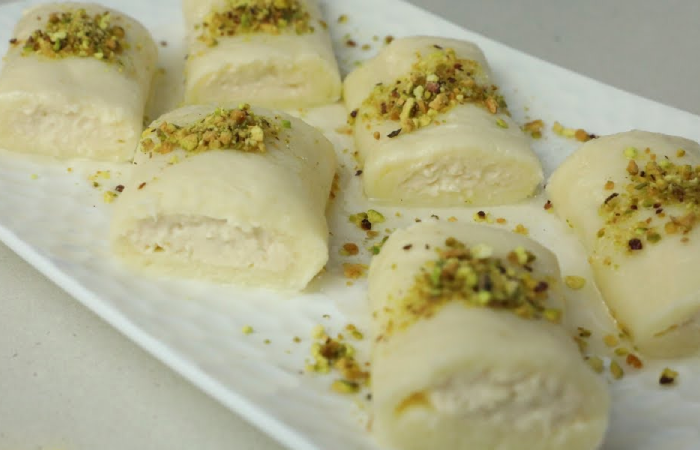
- Mix them with a sturdy spoon or hand mixer until it forms a soft dough.
- Add a teaspoon of milk or water at a time to the dough if it seems too dry.
- Between your palms, roll tiny, one-inch-diameter dough balls.
- Transfer the rolled balls to a parchment paper-lined dish.
- Gently press the chopped pistachios to cling to the balls after sprinkling them on top.
- You can also add cheese inside the balls.
- Once the bites are set, refrigerate for a minimum of half an hour.
- Before serving, dust with powdered sugar (optional).
Tips:
- Use full-fat mozzarella cheese for more intense flavor.
- You can use almonds or walnuts in place of the pistachios.
- You can substitute vanilla essence with rosewater.
- The cheese softens at room temperature, so it's best to serve these bite cold.
- Leftover bites can be kept for up to three days if stored in refrigerator.
- Use an airtight container to store them.
- You can quickly make these Halawet El Jibn bites with this no-bake recipe.
- They are ideal for treating yourself or sharing with loved ones.
Rose Milk Pudding Smoothie: A Refreshing Twist on Mahalabia
Desiring the cool take on the traditional Middle Eastern milk pudding, Mahalabia, with its silky, creamy texture? Try this smoothie made with rose milk. It tastes great and is a healthy alternative. It is a perfect cool treat on a hot day.
Ingredients:
- 1 cup unsweetened rose milk (or regular milk with 1-2 teaspoons rosewater)
- 1/2 cup plain yogurt (Greek yogurt for a thicker consistency)
- 1 frozen banana
- 1/4 cup chopped frozen dates
- 1/4 teaspoon ground cardamom (optional)
- 1/4 teaspoon honey (optional)
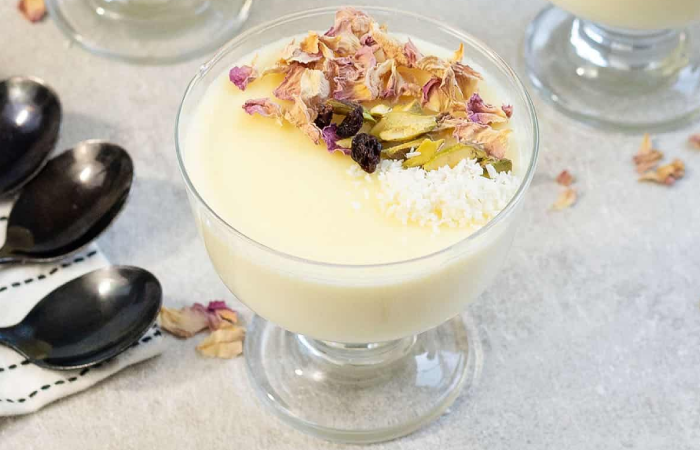
Preparation:
- Blend all ingredients mentioned above and process until smooth and creamy.
- If necessary, add additional rose milk or water to get the right consistency.
- If desired, use honey or another natural sweetener to alter the sweetness.
- Pour into glasses and savor!
Tips:
- To achieve a naturally sweet and creamy texture, use ripe, frozen bananas.
- To get the rose flavor, add one or two teaspoons of rosewater if using ordinary milk.
- Use rosewater ice cubes (prepared by freezing rose milk in advance) for a stronger rose taste.
- You can use chopped figs or apricots instead of the dates.
- Garnish with chopped nuts, honey, or a sprinkle of rose petals.
- Use your imagination to add your own special touches to your Rose Milk Pudding Smoothie!
Cheat's Znoud El Sit: Simplified Version of the Classic Pastry
Want to try the famous Middle Eastern phyllo rolls, Znoud El Sit, but lack the time or experience? Desperate for their flaky layers and sweet filling? With its easier preparation and use of easily found ingredients, this "cheat's" version makes it possible for you to savor this delectable dessert more quickly.
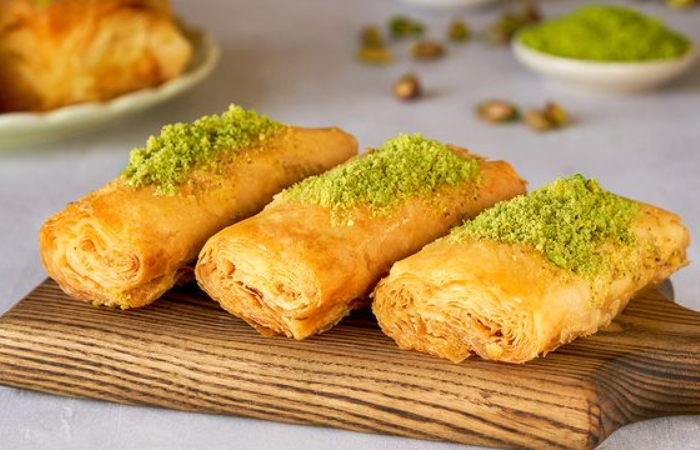
Ingredients:
- 1 sheet frozen puff pastry, thawed
- 1/2 cup ricotta cheese
- 1/4 cup sugar
- 1 tablespoon orange blossom water or rosewater (optional)
- 1 tablespoon chopped nuts (pistachios, almonds, walnuts, etc.)
- 1 egg yolk, beaten
- Sesame seeds, for sprinkling (optional)
Preparation:
- Preheat the oven to 200°C, or 400°F. Put parchment paper on one side of a baking sheet.
- Put the sugar, orange blossom water (or rosewater, if preferred), and ricotta cheese in a bowl. Mix until creamy and smooth.
- On a lightly floured surface, unfold the puff pastry sheet that has thawed. Quarter it into four equal pieces.
- Evenly distribute the ricotta filling into each square, distributing it in the middle of each.
- Fold each square into a roll so that the filling is encased in a rectangular shape.
- Lightly brush the beaten egg yolk over the top of each roll.
- The rolls should be baked for 15 to 20 minutes, or until they are puffy and golden brown, on the baking sheet that has been prepared.
- Top with sesame seeds, pistachio or nuts.
- Enjoy warm after allowing to cool somewhat before serving.
FAQ's about Znoud El Sit
1. What does the word Znoud mean?
- Znoud translates to "upper arm," and in joking reference to the creamy upper arms of chubby ladies, these delectable delicacies are termed Znoud el Sit, or ladies' upper arms.
2. Country Of Origin?
- Lebnon And Syria are cited as the origin places of this dessert.
Exploring Halal Ingredients in Middle Eastern Desserts
It is essential that we understand what halal ingredients entails in order to ensure that the desserts we make are in compliance with Islamic dietary requirements. These laws are based on the Hadith and the Quran.
Use of Halal Ingredients guarantees the ethical sourcing of each Item
For example:
- Any non-vegan product used is sourced from animals that are zabiha halal.
- Ingredients such as rennet, enzymes, and gelatin are obtained from halal sources.
- Facilities and equipment used for preparation are clean.
- They are free of contaminants from non-halal products.
- Alcohol or other prohibited substances are not present.
- Flavorings, thickeners, and emulsifiers used are halal certificated.

Common Halal Substitutions for Non-Halal Ingredients
- Use canola, coconut, or olive vegetable oils. Ghee, or clarified butter, is an additional option.
- Gelatin can be made with halal agar agar. Carrageenan and konjac gum work as substitutes.
- Conventional milk can be replaced with nondairy milk alternatives like soy, almond, or coconut milk.
- To simulate the flavor and acidity, use non-alcoholic grape juice concentrate, vegetable broth, or pomegranate juice.
- For added complexity, you can also incorporate orange blossom or rosewater.
- Use halal vinegar, which includes white, apple cider, and rice vinegar.
- pure vanilla powder or vanilla beans are substitutes for vanilla extract.
- An alternative to some animal-derived emulsifiers that is halal is lecithin made from sunflower or soy seeds.
Cultural Significance of Middle Eastern Desserts
Beyond just being delicious, Middle Eastern desserts have deep cultural importance. They are intricately entwined with the customs, festivals, and interpersonal relationships.
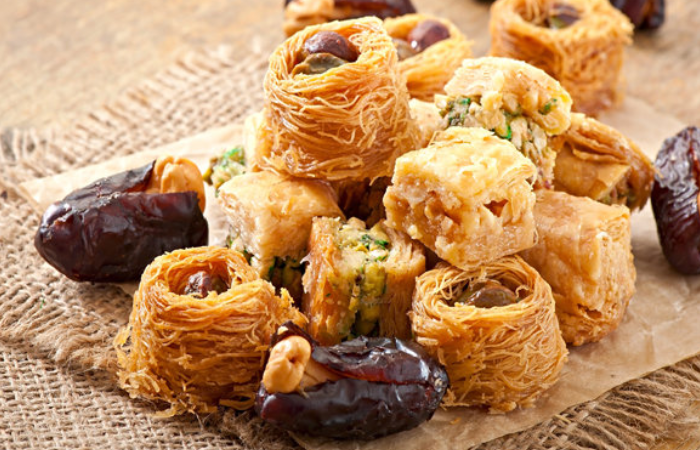
Recipes for traditional desserts are handed down through the generations, protecting cultural legacy and fostering a sense of identity. Certain flavors and substances trigger feelings of homecoming and nostalgia. The use of orange blossom water and rosewater, for instance, has specific cultural meanings.
Some desserts have religious significance associated with them. Qatayef are associated with fresh starts, and dates are significant during Ramadan. Knowing these links allows one to appreciate the subtle cultural nuances on a deeper level.
Symbolism and Traditions Associated with Specific Desserts
Baklava: This pastry with multiple layers is a symbol of prosperity, achievement, and good fortune. Baklava is a symbol of blessings and giving, particularly when it is distributed at Eid al-Fitr festivities and weddings.
Kunafa: The cheese filling represents wealth and luxury, while the golden color of the dish represents joy and celebration.
Malabi: This milk pudding is a symbol of grace and purity. Its silky texture and subtle flavor symbolize graciousness and sophisticated taste. It is presented to visitors as a token of honor and welcome.
Basbousa: This sweet, syrup-drenched semolina dish is a symbol of abundance and sweetness. This meal is commonly made during Ramadan and other special occasions; it represents blessings and kindness.
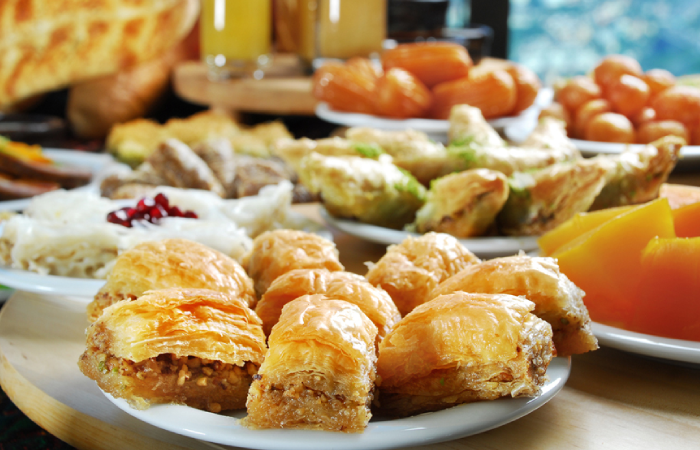
Desserts as a Form of Hospitality and Generosity
Middle Eastern culture is characterized by charity and hospitality, and sweets are a key component of this culture's expression. [How](How to Make Kombucha- Halal Perspectives, Benefits, and Risks) to do it is as follows:
- It is traditional to greet visitors with something sweet to express warmth, gratitude, and well wishes. It's not always polite to decline a dessert offer.
- Large dessert platters shared by all are set up in the middle of parties to promote sharing and a sense of cohesion.
- Making desserts or baking them for other people shows extra love and attention, as well as gratitude for them.
- Certain sweets have deeper cultural significance and are linked to various events and customs.
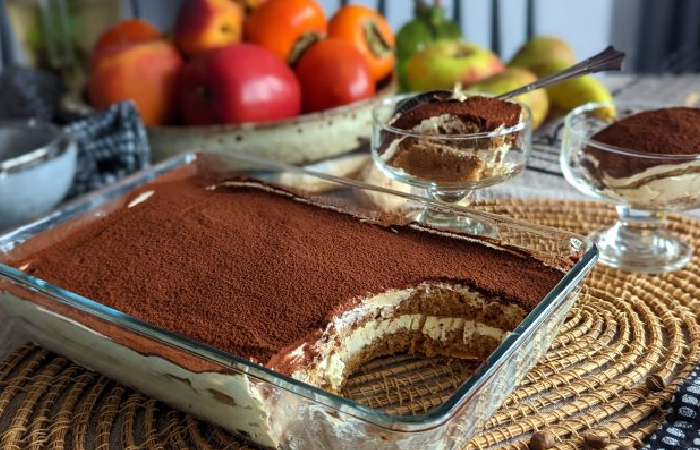
Health Benefits of Middle Eastern Desserts
Middle eastern desserts are very rich in nutritional value as they contains a lot of dry fruits , nuts and milk products. The nutritional components of the desserts are given in random below.
Nutritional Components of Key Ingredients
-
Nuts and seeds such as pine nuts, pistachios, almonds, walnuts, and sesame seeds are abundant in Middle Eastern desserts.
-
They provide antioxidants, fiber, protein, and healthy fats. They are also a great source of protein, monounsaturated fats, calcium, magnesium, vitamin K, and vitamin E.
-
Calcium, protein, vitamin D, and other essential components are provided by dairy products. Vitamins A and E are found in higher concentrations in whole-fat meals.
-
Probiotics (healthy gut bacteria), calcium, vitamin B12, and protein are all found in abundance in yogurt.
-
Spices having distinct scents and health advantages, such as antioxidants and anti-inflammatory qualities, include cinnamon, saffron, and cardamom.
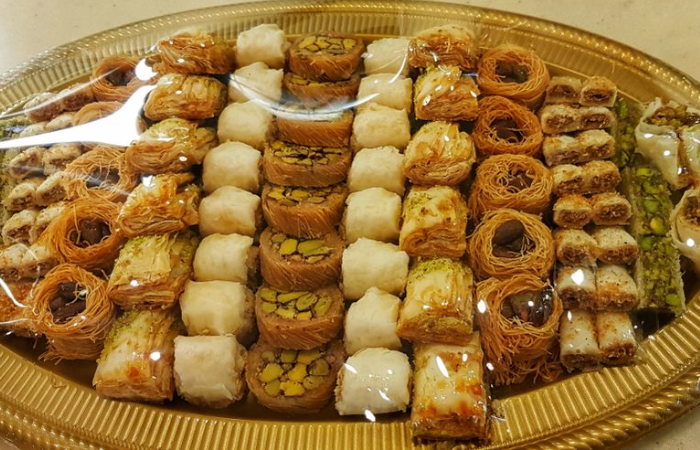
Moderation and Balance in Enjoying Desserts
-
Moderation and balance are essential in life. You can indulge in Middle Eastern delicacies while maintaining a conscious and healthful diet by using these suggestions.
-
Desserts made with natural ingredients, homemade with quality ingredients, or in fewer servings are preferable than ones with a lot of processing.
-
You can serve your dessert with fruits, nuts, or yogurt for extra fiber and nutrition.
-
Observe your body and stop eating when full, don't over eat.
-
Select candies that meet your entire nutritional needs by considering each one's sugar, fat, and calorie content.
-
Investigate healthier options by using whole-wheat pastry bases, or using natural sweeteners.
-
See a dietitian or other medical expert for individualized advice based on your dietary restrictions and health objectives.
-
Try making healthier versions of your favorite desserts by experimenting with different ingredients such as whole-wheat flours, reduced-fat milk, and natural sweeteners.
Conclusion
Recap of Middle Eastern Desserts
-
Middle Eastern delicacies bring sweetness into our lives and take center stage. They are frequently enhanced by rich textures (semolina cake, rosewater), floral scents (orange blossom water), and nutty undertones.
-
Among the well-liked sweets are Baklava, Kunafa, Umm Ali, Lokma, Malabi, Basbousa, Qatayef, Halva, Turkish Delight, and Maamoul.
-
Every locale adds a special touch that reflects the variety of foods and civilizations. Intricately intertwined with festivities, get-togethers, and displays of hospitality. They stand for happiness, prosperity, riches, community, and family.
Explore and Enjoy Halal Desserts Responsibly
- Explore the wide variety of restaurants that offer halal desserts if you want to savor Middle Eastern desserts.
- Recipes, suggestions, and cultural insights can be found on websites and blogs devoted to Middle Eastern and halal cooking.
- You can spend money on cookbooks that specialize in halal or Middle Eastern delicacies. Try out new recipes and methods in your own kitchen.
- Get a taste of real treats by traveling to the Middle East yourself.
Invitation to Engage with the Halal Blog Community for More Culinary Adventures.
Even though I've enjoyed sharing these recipes and facts with you, the exciting world of Middle Eastern desserts and Halal cuisine offers a plethora of culinary adventures just waiting to be discovered.
Here are a few ideas to carry on with your delectable adventure:
1. Explore blogs about Halal food:
Search for "Middle Eastern dessert blogs" or "Halal food blogs." A wealth of knowledge, recipes, and insights from passionate food admirers and chefs from different regions may be found here.
Halal Focus, Ummahpreneur, and We Halal Blog are a few well-liked choices.
2. Join in Online Groups:
Joining online forums, Facebook groups, or subreddits can help you get in touch with people who share your interest in Halal food and Middle Eastern desserts. Ask questions, discuss ideas, and share recipes with like-minded people.
3. Encourage nearby halal eateries:
Look for Halal eateries around and peruse their menus. Try a variety of foods and flavors, and get advice and inspiration for their cooking from the proprietors or chefs.
4. Get Cooking Channels Subscribed:
Middle Eastern desserts and Halal food are the focal points of numerous cookery programs and YouTube channels. You can pick up new skills, watch lessons, and acquire artistic inspiration for recipes of your own.
5. Purchase cookbooks devoted to Halal cooking
Invest in cookbooks that feature Middle Eastern delicacies and Halal cooking. Through in-depth recipe instructions and cultural insights, immerse yourself in the rich history and varied flavors of these culinary traditions.
Resources
https://richanddelish.com/middle-eastern-desserts/
https://insanelygoodrecipes.com/middle-eastern-desserts/
https://www.chefspencil.com/most-popular-middle-eastern-desserts/
https://www.thespruceeats.com/middle-east-desserts-4162479
Related Articles
https://www.thehalalplanet.com/middle-eastern-desserts-a-halal-culinary-journey/
https://www.thehalalplanet.com/basbousa-in-a-mug-microwave-friendly-single-servings/
https://www.thehalalplanet.com/10-minute-kunafa-parfaits-layers-of-crunch-and-creaminess/
https://www.thehalalplanet.com/quick-baklava-cups-bite-sized-treats-with-all-the-flavor/
https://www.thehalalplanet.com/exploring-halal-korean-bbq-a-culinary-journey/
https://www.thehalalplanet.com/is-tiramisu-halal-a-comprehensive-guide/
https://www.thehalalplanet.com/is-raising-canes-halal/
https://www.thehalalplanet.com/halal-mochi-ice-cream-recipe-a-delightful-treat-for-the-faithful/
https://www.thehalalplanet.com/how-to-make-kombucha-halal-perspectives-benefits-and-risks/
https://www.thehalalplanet.com/halal-diet-and-fitness/
https://www.thehalalplanet.com/halal-food-near-me-your-guide-to-halal-delicacies/
https://www.thehalalplanet.com/halal-and-kosher-practices/
https://www.thehalalplanet.com/halal-restaurents-in-birmingham/
https://www.thehalalplanet.com/what-does-halal-food-mean/
https://www.thehalalplanet.com/is-sushi-halal/
https://www.thehalalplanet.com/navigating-the-waters-of-halal-seafood-a-culinary-journey/
https://www.thehalalplanet.com/the-science-and-ethics-behind-halal-gelatin/
https://www.thehalalplanet.com/top-5-cities-for-halal-food-lovers-from-pizza-to-munchies
https://www.thehalalplanet.com/the-global-rise-of-halal-ice-cream/
https://www.thehalalplanet.com/halal-pizza-a-cultural-phenomenon-breaking-stereotypes/
https://www.thehalalplanet.com/is-daves-hot-chicken-halal/




